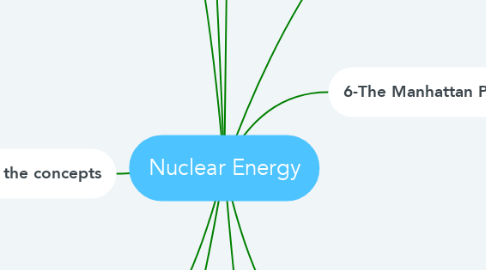Nuclear Energy
by Ahmed El Zemrany


1. 3-Nuclear physics in Russia
1.1. Russian nuclear physics predates the Bolshevik Revolution by more than a decade.
1.2. Work on radioactive minerals found in central Asia began in 1900
1.3. The 1917 Revolution gave a boost to scientific research
1.4. over 10 physics institutes were established in major Russian towns
1.5. In the 1920s and early 1930s many prominent Russian physicists worked abroad
1.6. By the end of the decade, there were cyclotrons installed at the Radium Institute and Leningrad FTI (the biggest in Europe).
1.7. Germany's invasion of Russia in 1941 turned much of this fundamental research to potential military applications.
2. 4-Conceiving the atomic bomb
2.1. British scientists had kept pressure on their government.
2.2. gave a major impetus to the concept of the atomic bomb in a three-page document known as the Frisch-Peierls Memorandum.
2.3. They proposed thermal diffusion as a suitable method for separating the U-235 from the natural uranium.
2.4. hain reaction could be sustained with slow neutrons in a mixture of uranium oxide and heavy water
2.5. earlier work by Halban and Kowarski soon after they arrived in Britain from Paris.
2.6. The Americans fortuitously suggested the same names, and the identification of plutonium in 1941 is generally credited to Glenn Seaborg.
3. 5-Developing the concepts
3.1. By the end of 1940 remarkable progress had been made
3.2. By March 1941 one of the most uncertain pieces of information was confirmed
3.3. The final outcome of the MAUD Committee was two summary reports in July 1941.
3.4. The huge resources of the USA were then applied without reservation to developing atomic bombs.
4. 7-The Soviet bomb
4.1. The test of the first US atomic bomb in July 1945 had little impact on the Soviet effort
4.2. Even before this was tested in August 1949, another group of scientists led by Igor Tamm and including Andrei Sakharov had begun work on a hydrogen bomb.
5. 9- Nuclear energy goes commercial
5.1. In 1964 the first two Soviet nuclear power plants were commissioned.
5.2. In Kazakhstan the world's first commercial prototype fast neutron reactor (the BN-350) started up in 1972, producing 120 MW of electricity and heat to desalinate Caspian seawater.
5.3. other countries have chosen light-water designs for their nuclear power programs, so that today 60% of the world capacity is PWR and 21% BWR.
6. 1-Exploring the nature of the atom
6.1. Uranium was discovered in 1789
6.2. by Martin Klaproth
6.3. in 1896 Henri Becquerel found that pitchblende (an ore containing radium and uranium)
6.4. Villard found a third type of radiation from pitchblende: gamma rays
6.5. the same as X-rays
6.6. in 1896 Pierre and Marie Curie gave the name 'radioactivity' to this phenomenon
6.7. n 1898 Samuel Prescott showed that radiation destroyed bacteria in food
6.8. At the end of 1938
6.8.1. Otto Hahn and Fritz Strassmann in Berlin showed that the new lighter elements were barium and others which were about half the mass of uranium

